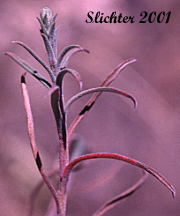Hoary aster (variety incana) as seen still in bloom atop the White Bluffs in the Hanford Reach National Monument.............October 25, 2013.
 The
photo at right shows hoary aster (variety incana) from the old gorge highway
between Celilo, OR and the mouth of the Deschutes River, Columbia River Gorge.........
September 15, 2001.
The
photo at right shows hoary aster (variety incana) from the old gorge highway
between Celilo, OR and the mouth of the Deschutes River, Columbia River Gorge.........
September 15, 2001.
Hoary aster is a fairly attractive biennial or short-lived perennial which would be well suited for the dryland garden. In form, it varies from several lightly branched stems to plants which are diffusely branched, and in size from 10-100 cm high. Its herbage ranges from canescent-puberulent to stipitate-glandular. It may occasionally be entirely lacking of any hairs. The basal leaves range from spatulate to linear-oblanceolate in shape with serrate to entire margins, and range up to 10 cm long and 15 mm wide. The basal leaves may be deciduous by bloom time. The stem leaves are alternately arranged and are generally smaller in size as well as linear in shape (See photo below.).
The numerous flower heads are at the tips of the main stem or side branches. The 8-50 rays are a bright bluish purple and range form 5-12 mm long. These surround a narrow, yellowish central disk. The involucreranges from 6-10 mm high with canescent and/or glandular herbage with overlapping, outwards reflexed bracts with short greenish, squarrose tips.
Variety incana has large flower heads with up to 50 rays and more vigorous growth.
Hoary aster is found in open, dry habitats from the lowands to more than 3000 meters in the mountains. It is probably more common at lower elevations.
Hoary aster may be found over much of western North America. It is found fromBritish Columbia south (to the east of the Cascade Mts.) to southern California and east to North Dakota,, South Dakota, Nebraska, Nevada, cdentral ARizona, and central New Mexico.


